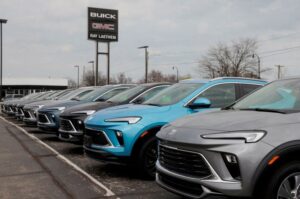U.S. New Vehicle Prices Surge: Insights and Implications
April 2023 marked a significant uptick in new vehicle prices across the United States, driven largely by ongoing auto-tariff measures and shifting market dynamics. According to data from Cox Automotive’s Kelley Blue Book, the average transaction price—with discounts factored in—rose by 2.5% from March. This increase starkly contrasts the typical 1.1% increment seen in preceding years, underscoring the broader economic impact of tariff policies on consumer behavior and automotive sales.
The Tariff Ripple Effect
As the automotive industry grapples with a 25% tariff on vehicle imports, particularly from key trading partners like Mexico and Canada, many manufacturers have opted against raising sticker prices. Notably, automakers such as Hyundai, Ford, and Stellantis have implemented promotional offers to maintain buyer interest and safeguard their sales figures. However, consumer demand remains resilient, spurred by fears of future price hikes that could accompany these tariffs.
Erin Keating, a lead analyst at Cox, highlighted the inflationary pressures influencing specific vehicle models. "Consumer expectations can create a self-fulfilling prophecy," she noted, explaining that heightened demand for certain vehicles results in increased local pricing dynamics at dealerships. The result? Consumers are now investing more at the dealership than they might have anticipated.
Price Adjustments Across the Board
Recent reports indicate that Ford has begun to charge more for its Mexico-produced models. Specific vehicles, including the Mustang Mach-E electric SUV and the Bronco Sport, have seen price increases of up to $2,000. This move reflects a broader trend: while many automakers are leveraging promotions to fortify buyer confidence, the looming presence of tariffs is inevitably influencing price points.
Additionally, wholesale prices for used vehicles have climbed 4.9% over the past year, suggesting an ongoing trend in upward pricing momentum across the board. As reported by the Cox’s Manheim Used Vehicle Value Index, this figure not only reflects the current market but also hints at potential future pressures.
The Stability of Promotions
Despite rising prices, promotions are keeping overall costs relatively stable, as evidenced by comments from Todd Szott, dealer partner at Szott Automotive Group, which operates several dealerships in Metro Detroit. Recent statistics reveal that sales incentives, as a percentage of new car transaction prices, have fallen to their lowest levels since summer 2024, indicating a shift in dealership strategies.
However, the dwindling inventory of vehicles on dealer lots poses a warning sign for potential price increases in the coming months. Data shared by Cox Chief Economist Jonathan Smoke indicated that fewer than 2.6 million vehicles are currently available to consumers, suggesting that tightening supply alongside rising demand could lead to heightened competition and a subsequent spike in prices.
Future Market Prospects
Industry experts remain cautiously optimistic yet vigilant. Paul Zimmermann, partner-owner at Matick Automotive Group, expressed concerns over vehicle pipeline stability. “While things appear robust now, we need to monitor for any unexpected disruptions,” he cautioned.
Cox estimates that vehicles directly affected by tariffs could see price increases of 10% to 15%, while those less impacted may still experience a 5% rise. Keating forecasts that while substantial increases aren’t likely in the near term, long-term adjustments may occur around model-year changeovers.
As consumers navigate this evolving landscape of vehicle pricing, staying informed will be key. Whether it’s understanding the implications of tariffs or evaluating promotional deals, being proactive will empower buyers in making well-informed decisions amidst this fluctuating automotive market.
For the latest insights on automotive trends, price forecasts, and consumer strategies, stay tuned to Extreme Investor Network. Your go-to source for maximizing your financial acumen in an ever-changing economic environment.

